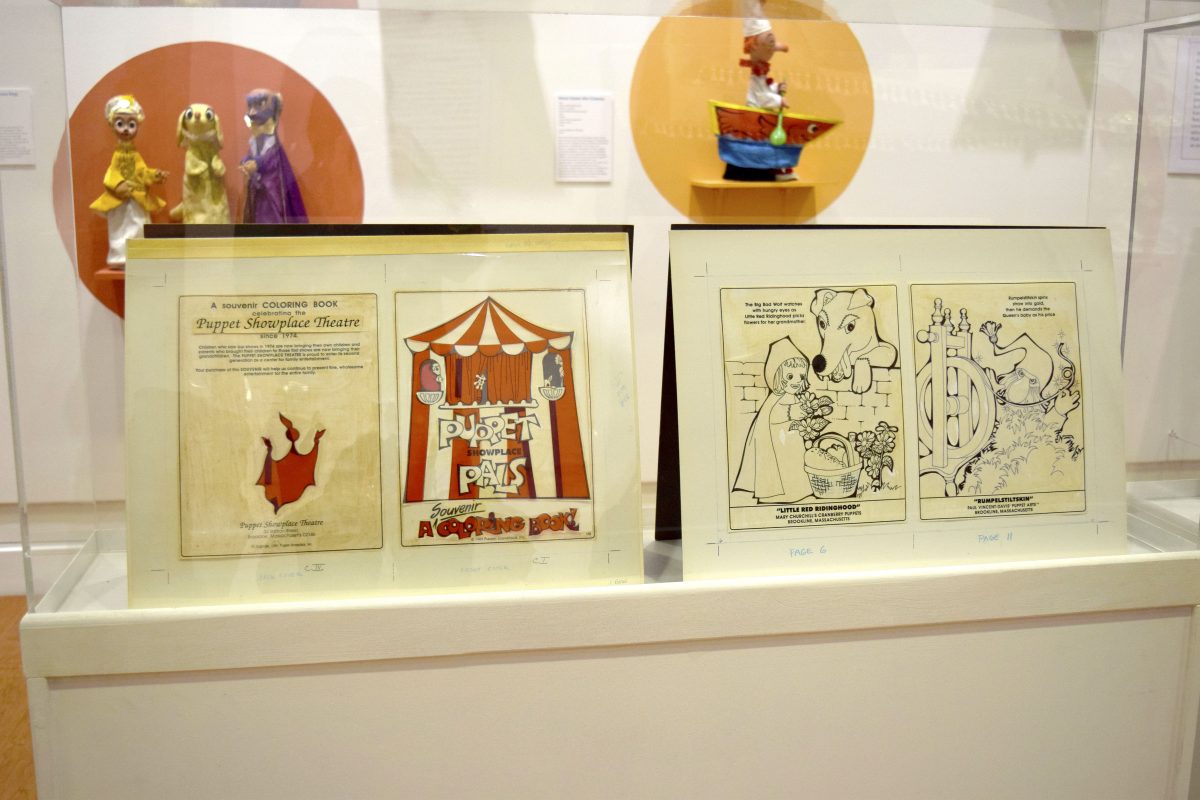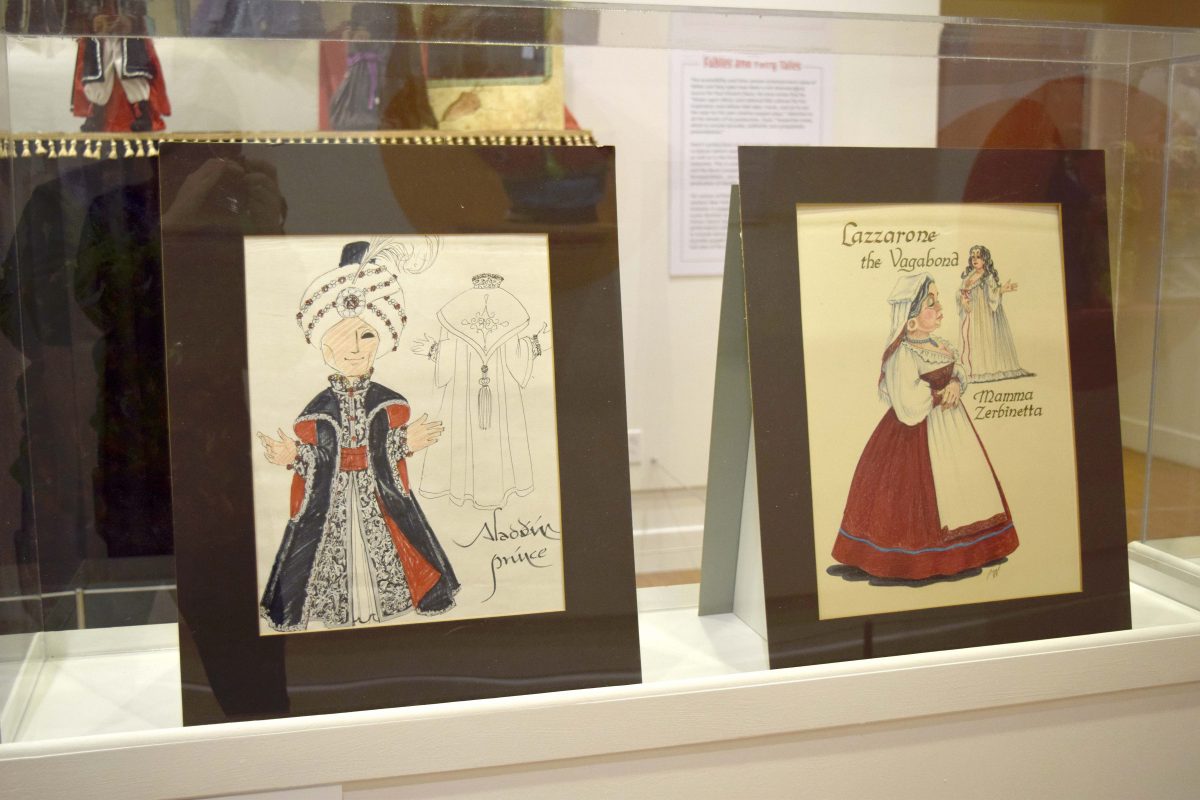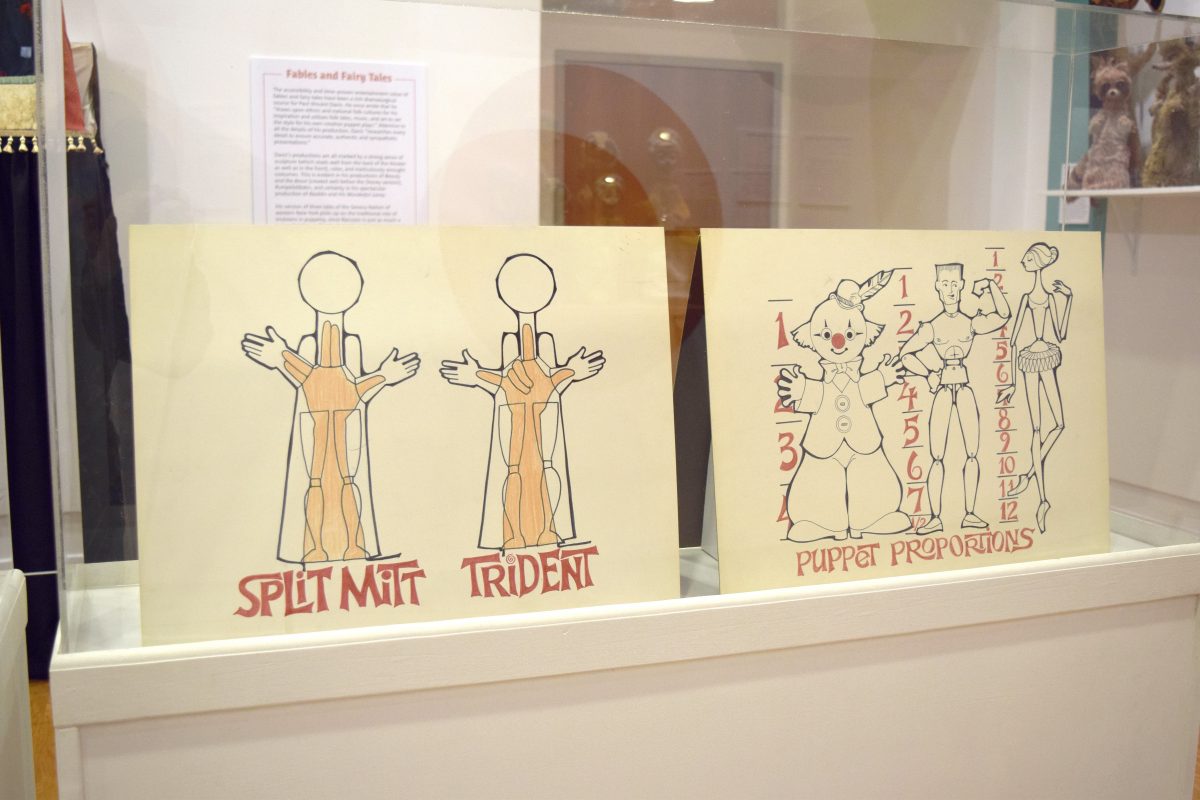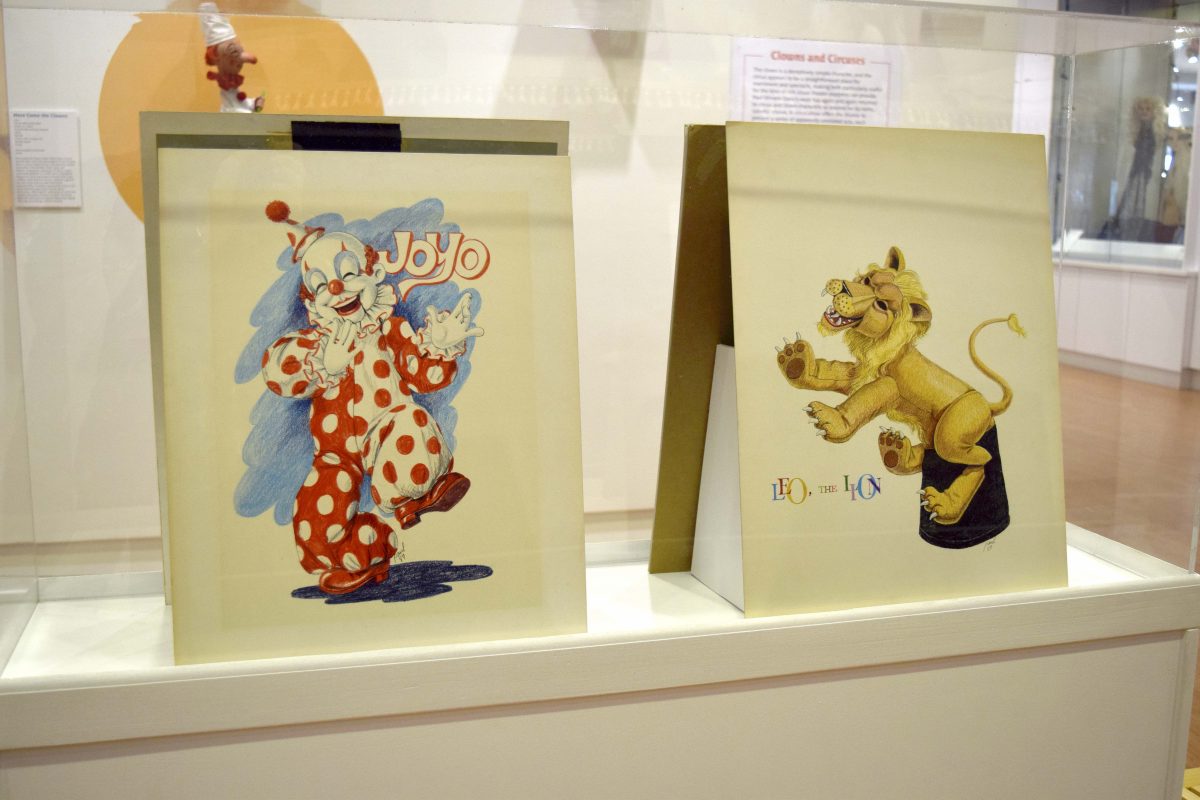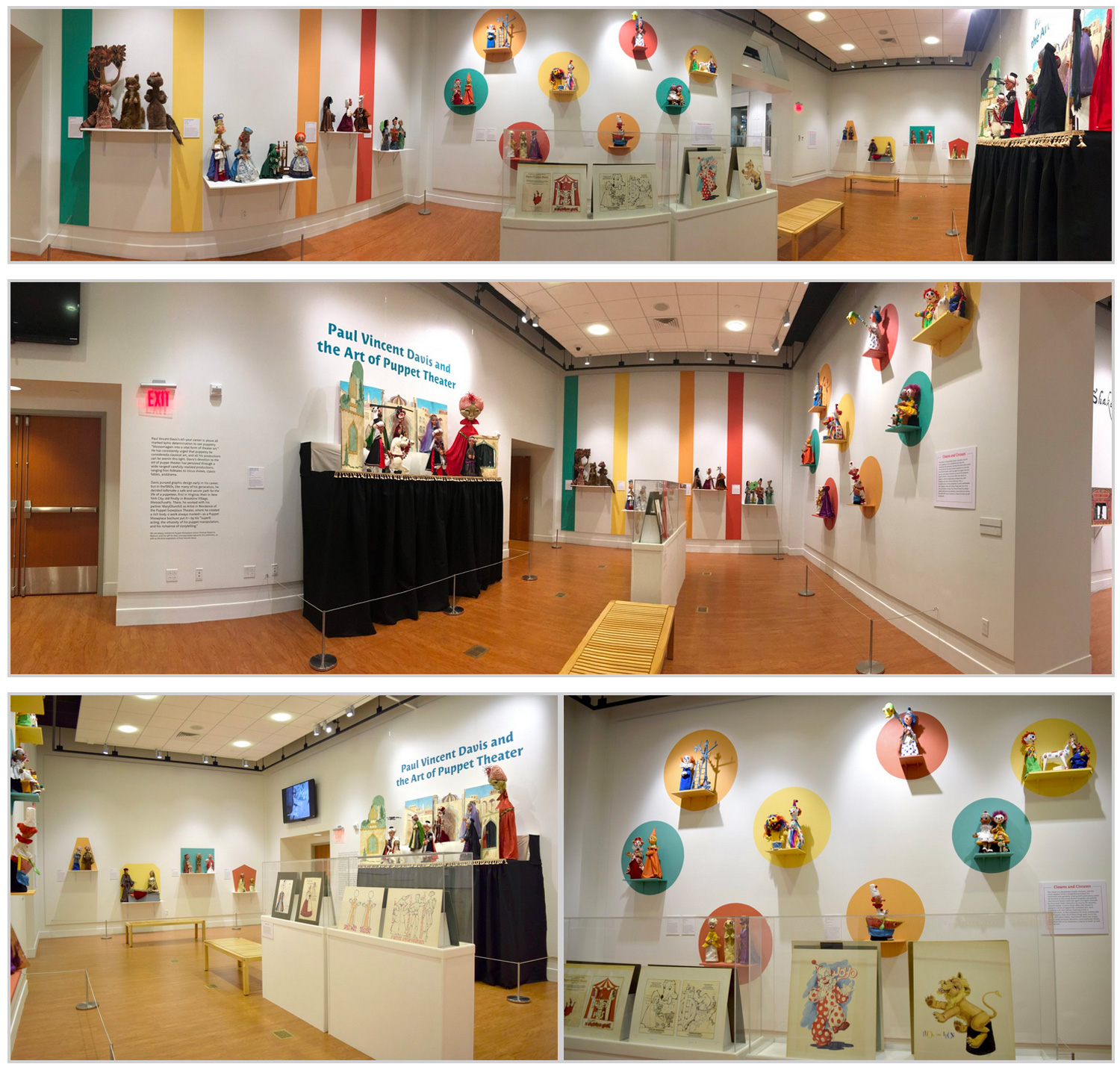
Paul Vincent Davis’s 60-year career is above all marked by his determination to see puppetry “blossom again into a vital form of theater art.” He has consistently urged that puppetry be considered a classical art, and all his productions can be seen in this light. Davis’s devotion to the art of puppet theater has persisted through a wide range of carefully realized productions, ranging from folktales to circus shows, classic fables, and drama.
Davis pursued graphic design early in his career, but in the 1960s, like many of his generation, he decided to forsake a safe and secure path for the life of a puppeteer, first in Virginia; then in New York City; and finally in Brookline Village, Massachusetts. There, he worked with his partner Mary Churchill as Artist in Residence of the Puppet Showplace Theater, where he created a rich body of work always marked—as a Puppet Showplace brochure put it—by his “superb acting, the virtuosity of his puppet manipulation, and his rich sense of storytelling.”
We are deeply indebted to Puppet Showplace Artistic Director Roxanna Myhrum and her staff for their immeasurable help with this exhibition, as well as the kind cooperation of Paul Vincent Davis.
Fables and Fairy Tales
The accessibility and time-proven entertainment value of fables and fairy tales have been a rich dramaturgical source for Paul Vincent Davis. He once wrote that he “draws upon ethnic and national folk cultures for his inspiration and utilizes folk tales, music, and art to set the style for his own creative puppet plays.” Attentive to all the details of his production, Davis “researches every detail to ensure accurate, authentic and sympathetic presentations.”
Davis’s productions are all marked by a strong sense of sculpture (which reads well from the back of the theater as well as in the front), color, and meticulously wrought costumes. This is evident in his productions of Beauty and the Beast (created well before the Disney version), Rumpelstiltskin, and certainly in his spectacular production of Aladdin and His Wonderful Lamp.
His version of three tales of the Seneca Nation of western New York picks up on the traditional role of tricksters in puppetry, since Raccoon is just as much a suave deceiver as Punch, Guignol, or Javanese wayang’s Semar. Davis’s fascination with Japanese puppetry and performance culture expands beyond stories themselves to include dance, ritual, and the particular aesthetics of bunraku puppet shows, where the puppeteer works in full view of the audience.
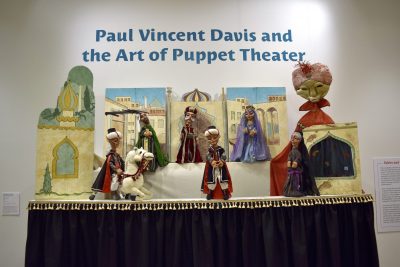
Aladdin and His Wonderful Lamp
1986
Hand puppets, rod puppets, and set pieces
Aladdin and his Wonderful Lamp was Paul Vincent Davis’s most elaborate solo performance. Combining a two-level stage with over twenty-one hand puppets with luxurious costumes made by Karen Larsen, as well as two oversize rod puppets, the show was introduced and narrated by Davis in his own Arabian costume. The process of creating the production is documented in Kathryn Lasky’s book Puppeteer.
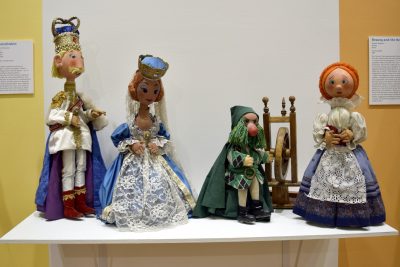
Rumpelstiltskin
1980
Hand puppets and set pieces
Paul Vincent Davis created his version of Rumpelstiltskin—which he subtitled “Hilda’s Lament, or Please Don’t Take My Baby!”—as “a romantic comedy for hand puppets.” Rumpelstiltskin the troll spins straw into gold so servant girl Hilda can marry King Wilhelm, “but asks a terrible price as payment for completing the task,” Davis writes, and later returns to demand Hilda’s new baby. Rumpelstiltskin won’t take the baby if Hilda can guess his name, and “quite by accident” she discovers this information, which she announces to the troll, thus saving the day.
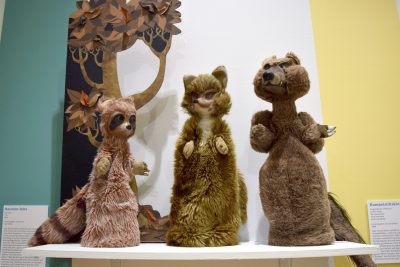
Raccoon Tales
Late 1960s
Hand puppets and props
Paul Vincent Davis created Raccoon Tales in New York City as one of six shows commissioned by the city’s Parks Department. The production is based on Skunny Wundy: Seneca Indian Tales, a 1926 anthology of stories collected by Seneca anthropologist Arthur Caswell Parker (Gawasa Wanneh) while he was growing up on the Cattaraugus Reservation in upstate New York. Davis took over a year to create the production, building the puppets with UConn Puppet Arts Program alumna Karen Larsen, and including such tales as “How the Fox and the Raccoon Trick Each Other,” “Why the Blue Jay is Blue and the Gray Wolf Isn’t,” and (depicted here) “Why the Bear has a Stumpy Tail.” Puppeteer Brad Shur re-mounted the show in 2012 under Davis’s direction while working as Artist-in-Residence at the Puppet Showplace Theater.
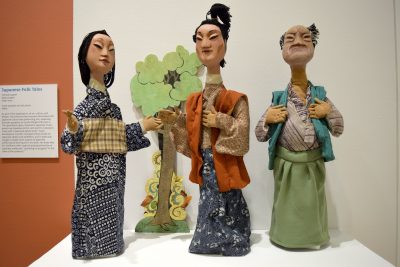
Japanese Folk Tales
1980's
Hand puppets and set piece
As part of his explorations of art, culture, and theater, Paul Vincent Davis became fascinated with Japanese culture and performing arts, especially bunraku puppetry. As Lynda Morgenroth puts it, “he read about Japan, listened to Japanese music, pored over Japanese prints and went to Canada to study with a Japanese kabuki actor.” Davis developed a number of puppet shows based on Japanese stories and aesthetics, and in particular sought to adapt some aspects of Japanese performance techniques in his work. He wrote that he “performs with a special technique familiar to Japanese audiences,” operating his puppets “in full view of the audience.”
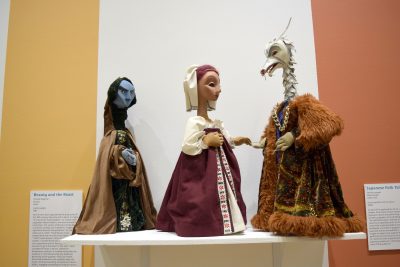
Beauty and the Beast
1983
Hand puppets
Paul Vincent Davis approached his production of this 18th-century fairy tale with a desire to create “a romance for hand puppets.” Co-written with puppeteer Eleanor Boylan, who also directed the production, this version of Beauty and the Beast as a romantic comedy was marked by “subtle but significant feminist interpretations,” as The Boston Globe put it, which “made Beauty more independent and her sisters less mean.” Davis said “I didn’t want Beauty’s sisters to be villainous and spiteful. I wanted the family to be more helpful and cooperative and for Beauty to make the decision to go to the Beast on her own.” Davis narrated the show in person, dressed in Renaissance costume. A reviewer wrote that the audience is “not distracted by any theatrical gimmickry of the puppets—they are simple, hand-held characters with molded heads and hands. Yet they beautifully complement Davis’s skillful, engaging storytelling to bring the drama, comedy, and emotional poignancy of the play vividly to life.”
Clowns and Circuses
The clown is a deceptively simple character, and the circus appears to be a straightforward place for merriment and spectacle, making both particularly useful for the kind of rich visual theater puppetry can provide. Paul Vincent Davis’s work has again and again returned to circus and clown characters as sources for dynamic, colorful stories. A circus show offers the chance to present a series of apparently unrelated acts, each building to its own climax involving a trick, a transformation, or the completion of some unbelievable feat. Puppetry does all of these things well, but in his circus and clown shows, Paul Vincent Davis has always added some particular elements, some particular stories, that allow the circus characters a chance to teach as well as entertain.
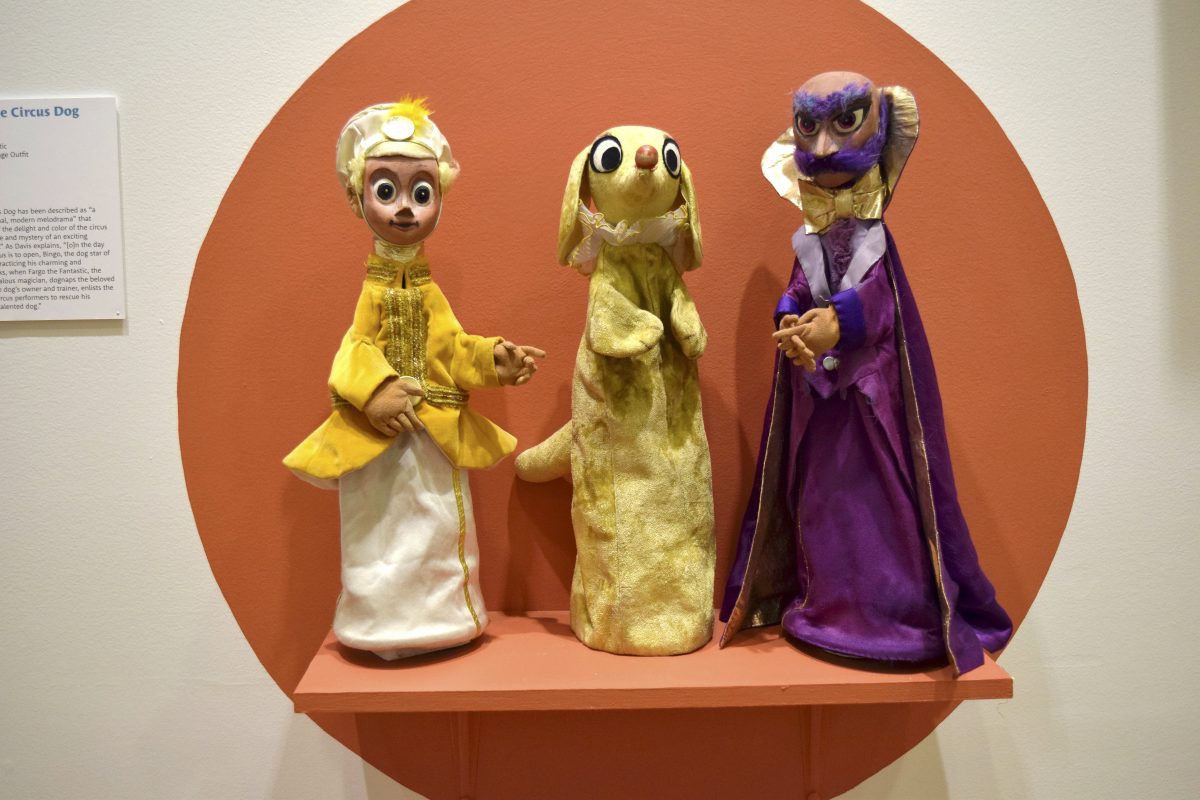
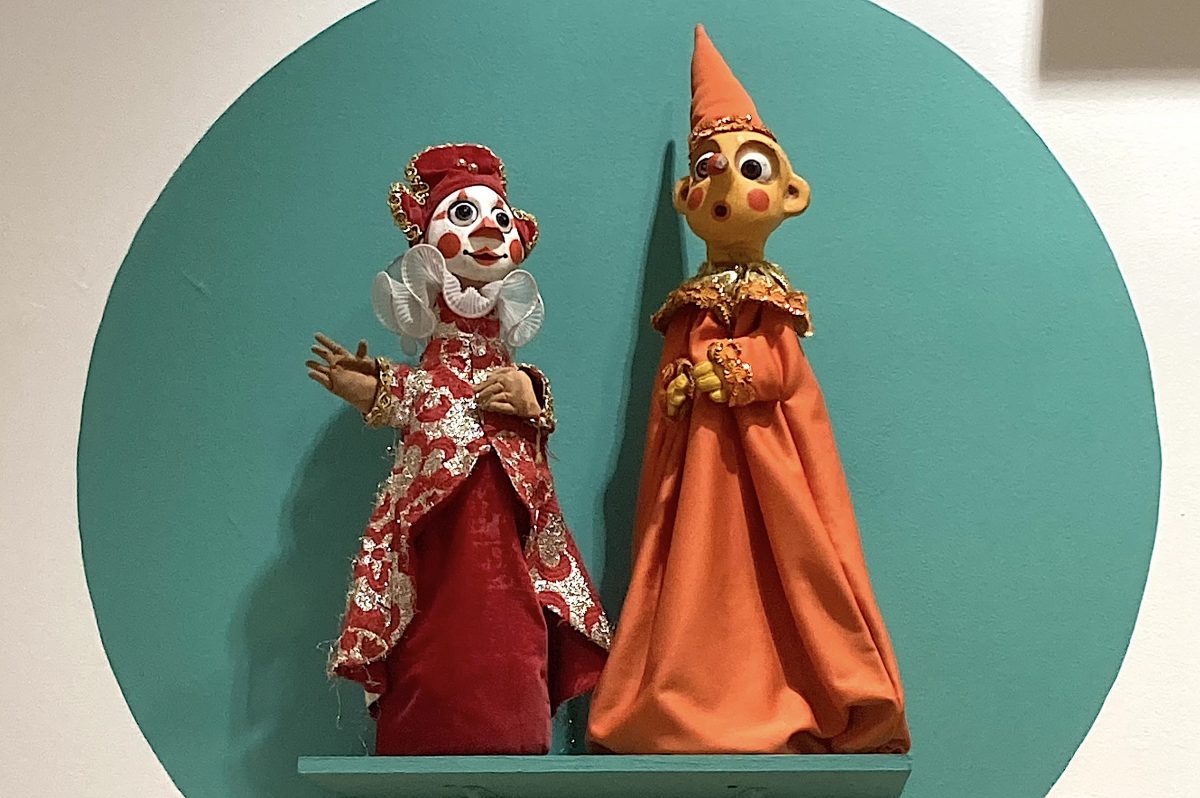
Bingo the Circus Dog
1970's
Hand puppets
Bingo the Circus Dog has been described as “a beguiling original, modern melodrama” that “captures all of the delight and color of the circus and the intrigue and mystery of an exciting adventure tale.” As Davis explains, “[o]n the day before the circus is to open, Bingo, the dog star of the circus, is practicing his charming and whimsical tricks, when Fargo the Fantastic, the wicked and jealous magician, dognaps the beloved pooch. J.J., the dog’s owner and trainer, enlists the aid of other circus performers to rescue his beloved and talented dog.”
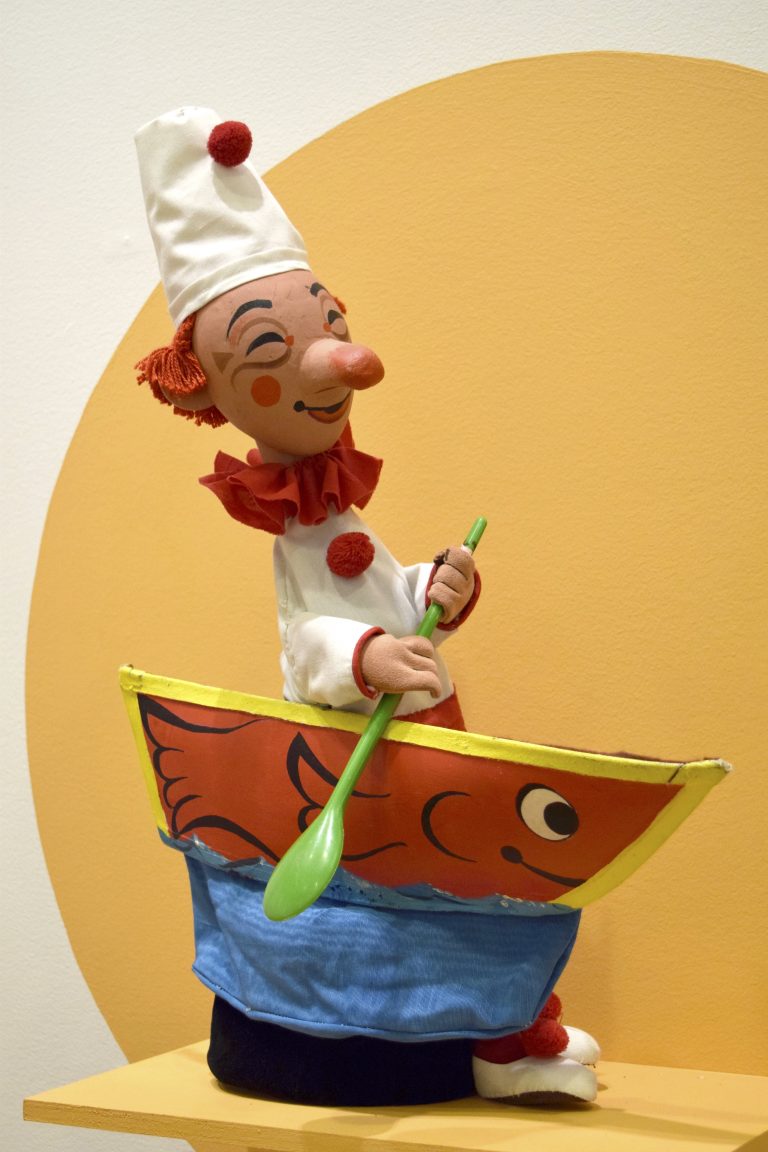
Here Come the Clowns
2006
Hand puppets and props
Here Come the Clowns (later titled Clown Circus) was the last, and most extravagant of Paul Vincent Davis’s circus-related shows, and featured several characters—Ponchinella, Tarta, Zany, and Pierrot—inspired by characters of classic Italian commedia dell’arte. In a 2007 issue of Brookline Magazine, Davis expressed a concern that many children were afraid of clowns, and that a goal of his new show was to make them more approachable. A notable aspect of the show is the racial diversity represented by the clown characters, reflecting the community of which the Puppet Showplace Theater is a part. The show featured interactive variety acts featuring singing, dancing, storytelling, and lion-taming.
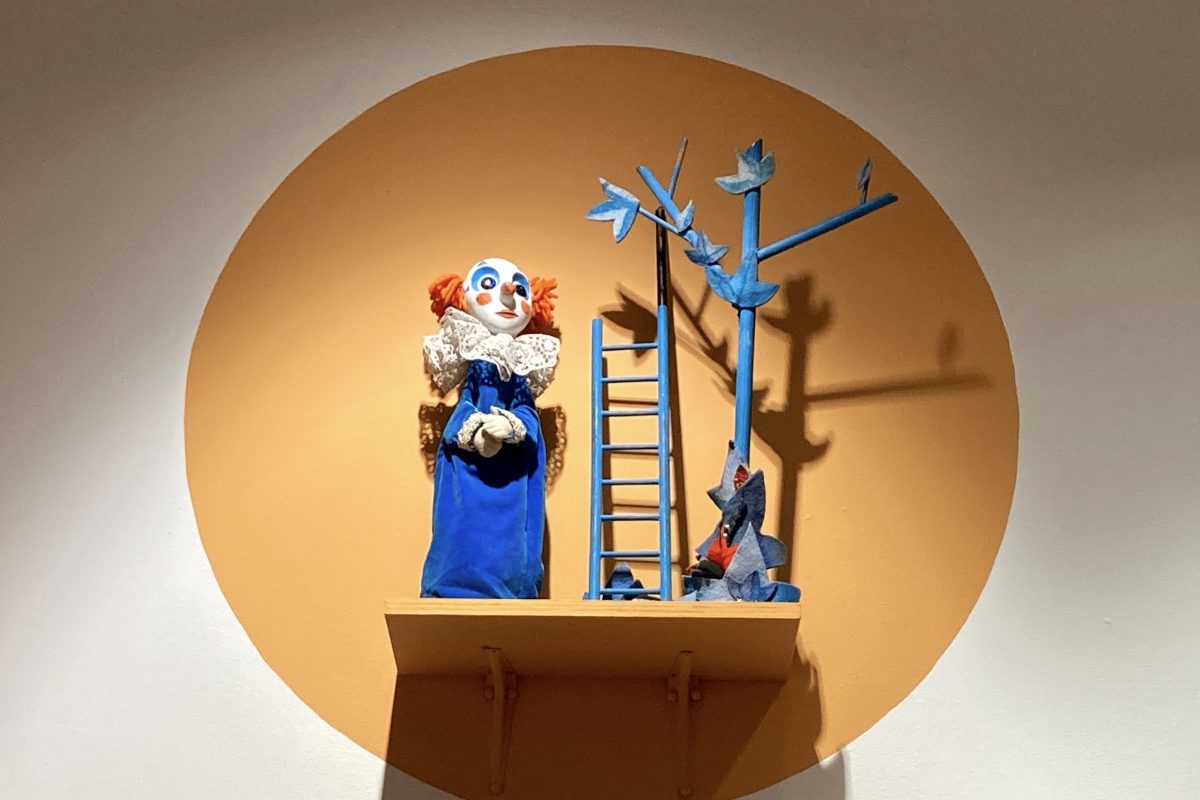
Jojo and His Orange Ball
1991
Hand puppet and props
Jojo and his Orange Ball appears to have a lot in common with Paul Vincent Davis’s other clown and circus shows. “Jojo is the Ball Bouncing Clown,” Davis wrote in describing the show, “and is very proud of his skills, but he suddenly loses control and his bright orange ball ends up at the top of a tree. His hilarious antics and his all too human frustrations will delight audiences of all ages as he tries to retrieve his ball.” Jojo’s increasing frustration in getting the ball back, and his increasingly elaborate attempts to do so—involving a surprisingly animate and sympathetic ladder—are not only amusing, but bring to mind the dry absurdity of playwright Samuel Beckett’s work, which Davis also performed.
Puppets as Modern Theater
While Paul Vincent Davis has always created puppet shows that delight and entertain, his sense of the art of puppet theater includes the possibility of performing the same kinds of serious subject matter as actors’ drama. Davis’s late-60s work in New York City with Carol Fijan as the National Theatre of Puppet Arts resulted in a variety of Shakespeare puppet productions examining the ways the Bard’s words might be delivered by hand or rod puppets, such as Richard III, wherein the eponymous king’s outrageous seduction of newly widowed Lady Jane takes place in front of the corpse of her husband, recently murdered by Richard himself. This sense of the serious possibilities of puppetry characterizes Davis’s 1990 production of Shakes versus Shav—which George Bernard Shaw wrote in 1949 for English puppeteer Waldo Lanchester—where Shaw and Shakespeare argue, even fistfight, to decide who is the best writer. Davis’s productions of Androcles and the Lion and The Golden Touch of King Midas, which he presented together in 1988 as Fables of Ancient Rome, are whimsical yet serious moral tales.
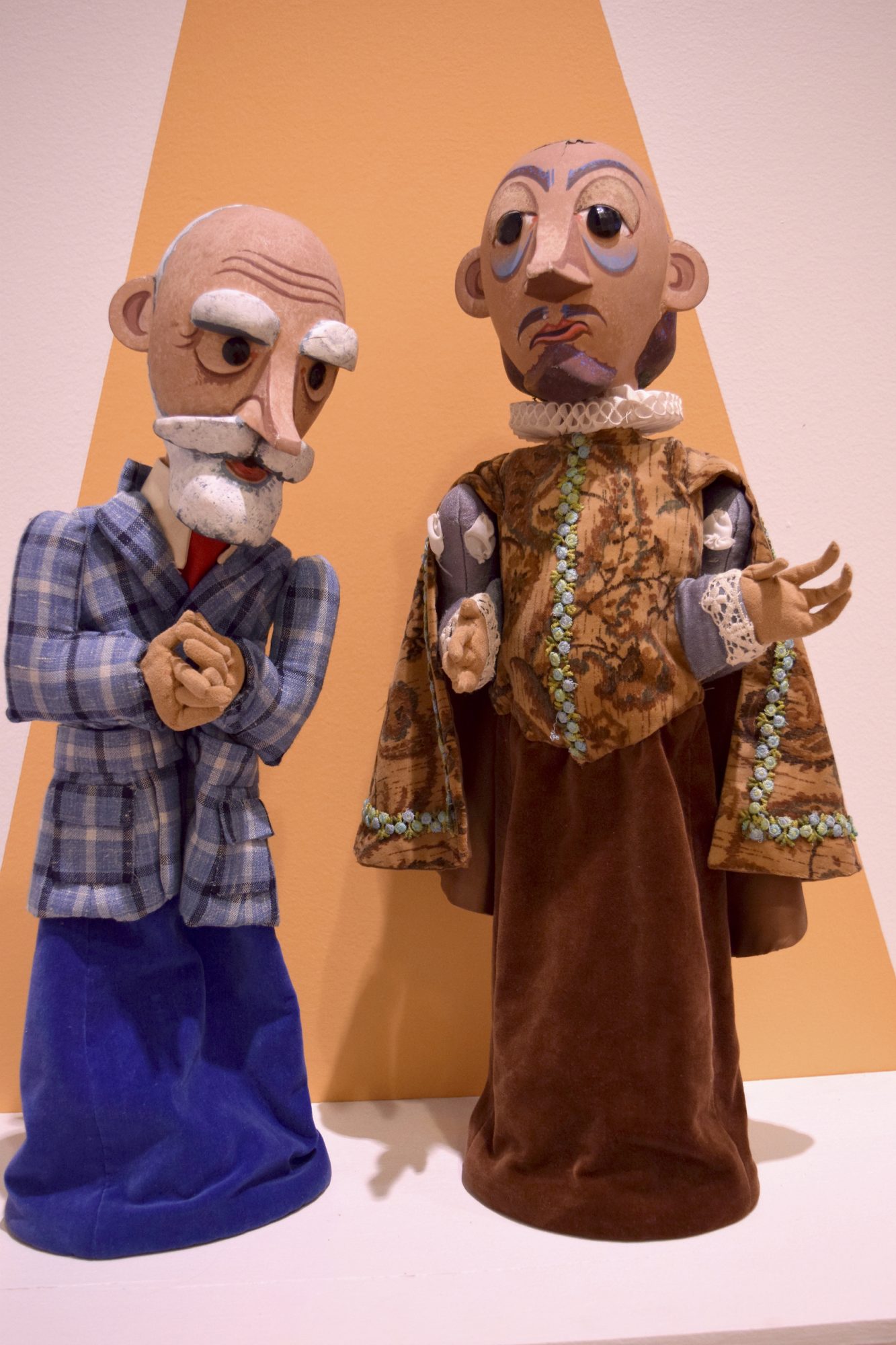
Shakes versus Shav
1990
Hand puppets
In 1949 British puppeteer Waldo Lanchester sent playwright George Bernard Shaw portrait puppets of both Shakespeare and Shaw, asking the latter to write a play for them. Intrigued that the puppets’ “unvarying intensity of facial expression, impossible for living actors, keeps the imagination of the spectators continuously stimulated,” Shaw wrote Shakes versus Shav as an outlandish Punch-and-Judy-style conflict between two headstrong artists contesting who is the best writer. Davis performed the comedy in 1991 at a Long Island conference devoted to Shaw, and a writer for the Journal of the Shaw Society wrote that “[n]o praise is too high” for the show, adding: “So convincing were the main figures of Shakes and the usurper Shav in their verbal and physical fighting [...] that when the puppeteers took their bow at the end, with their little mannikins in their hands, it was a great surprise to see that the ‘characters’ in the play so alive a moment before, were in reality, merely inanimate models.”
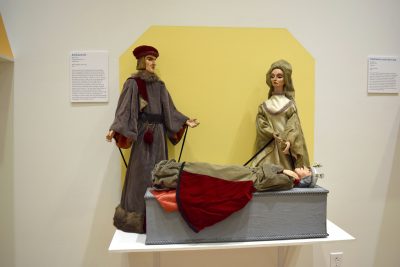
Richard III
1971
Rod puppets and prop
Paul Vincent Davis created these outstandingly bold rod puppets for performances of an excerpt from Shakespeare’s Richard III, a historical drama about an exceedingly evil monarch who states “I am determined to prove a villain.” In Act 1, Scene 2, Richard encounters Lady Anne accompanying the corpse of her husband, the late King Henry VI, whom Richard himself had murdered. Davis enacted Richard’s outrageous seduction of Lady Anne over her husband’s body, wherein Richard makes such claims as “He that bereft thee, lady, of thy husband, / Did it to help thee to a better husband,” thus admitting the murder, but claiming he did it in order to marry her. Amazingly, he succeeds, and she accepts his ring, thus concluding one of the most successful examples of persuasive language in the dramatic canon.
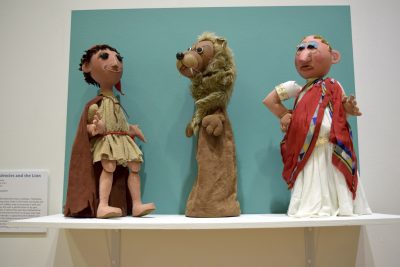
Androcles and the Lion
1988
Hand puppets
Davis described this show as follows: “Androcles, a runaway slave, hides in the forest and eludes the Emperor’s soldiers only to encounter a wild and ferocious lion with a painful thorn in its paw. Androcles, in spite of his own fear, befriends the lion and removes the thorn so its paw may heal. Later, Androcles is captured by the soldiers and taken to the coliseum to be punished. Androcles saves the Emperor’s life and the lion rescues Androcles thus bringing this hilarious comedy to a rousing and happy ending.”
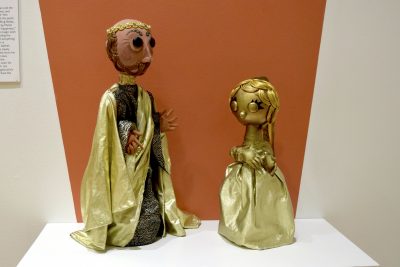
The Golden Touch of King Midas
1988
Hand puppet and figure
Davis performed this show and Androcles and the Lion as Fables of Ancient Greece and Rome, and wrote that such classic tales could teach “the lessons of the rewards of friendship and the perils of greed.” In his version of the story of King Midas, directed by Eleanor Boylan, with music by Phred Churchill, Bacchus, “the god of fun and happiness,” as Davis puts it, “grants King Midas one magic wish as a reward for a service. Midas, unheeding the warning of Bacchus, hastily wishes that everything he touches will turn instantly to gold. In a twinkling he has the Golden Touch. He dashes about his garden delightedly testing his newly acquired skills turning everything to gold; from his clothing, the walls of his castle, to the roses themselves. Tired and hungry from all the excitement, Midas soon discovers that even his food and drink turn to gold at his touch. His beloved daughter, Sirena, is turned to gold at his touch. At last he begs Bacchus to take back the dreadful gift.”
Graphic Design
Paul Vincent Davis, like many significant American puppeteers, was trained as a graphic designer and worked in art studios, print shops, and ad agencies until the stress of a job as art director at a New York City agency helped him make a decisive turn towards puppetry. Davis’s graphic designs, as can be seen here, show a bold use of line, clarity of image, strong character, and a sense of humor, all of which are also reflected in his equally strong designs for his puppets.
